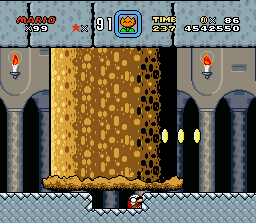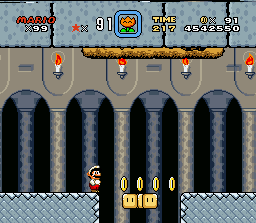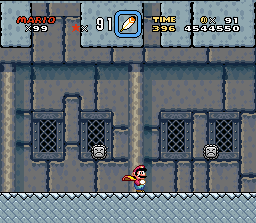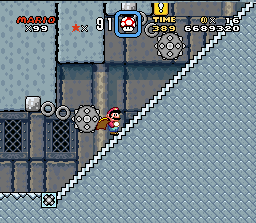The Periodic Enemies Theme
The periodic enemies theme is about enemies that move in predictable, perpetual loops. This is not limited to literal loops; periodic enemies can move back and forth or up and down, as long as that movement is regular and repeating. The "period" of an enemy is the length of time it takes that enemy to complete one of these loops. Additionally, this definition includes "inanimate" enemies like fireballs and sharpened spikes, as long as they exhibit that predictable periodic behavior. The periodic enemies theme is, in a sense, like the inverse of the moving targets theme. Where the moving targets theme saw Mario aiming for cycling, patrolling and otherwise regularly moving platforms, this theme sees him aim away from cycling, patrolling, and otherwise regularly moving enemies. This makes sense inasmuch as the two themes are complementary. As this book notes many times, Super Mario World is a composite of the platforming and action genres, and this skill theme makes use of the action side of the timing idea. This is not to say that this theme completely abandons the platforming genre; a composite game never truly abandons either of its constituent genres. But the jumping in this theme is definitely downplayed, and this is reflected in a key stat. The periodic enemies theme has the lowest delta-height of any theme, which means that when jumps come in this theme, they're usually small. Like in the moving targets theme, this is because the jumps in this theme are about timing rather than momentum. (That this theme has the second lowest d-distance backs this up.) In this case, most of the key jumps in this theme are about avoiding the periodic movements of an enemy, and the jumps needed to do so rarely exceeds the height or width of a regular enemy, which is never that large. Much of the time a jump isn't necessary at all, and this is why the theme is in the action declension.
The periodic enemies theme is in the action declension not because there is a great deal of combat (as there is in the intercepts theme) but because the player is often forced to do the non-combat task common to action games: precise movement. Consider that Galaga, Golden Axe and Prince of Persia all have in common the need for the player to steer their avatar around enemy obstacles precisely. Even though combat is an option in those gamesóand indeed the most prominent optionóthe player's success also depends on evasion and timing. This is what the player has to do much of the time in the periodic enemies theme in Super Mario World. The theme isolates non-jump movement by use of terrain and the second-most important property of most periodic enemies.

The pathways above both make jumping more difficult than simply walking precisely. Both also feature periodic enemies that are invincible (the BallíníChain). That invincibility is a key part of the periodic enemies theme in that it completely eliminates combat solutions. In the other themes, some kind of combat might improve the outcome of a given challenge, but in the periodic enemies theme this is less common because of the invincibility of most of the enemies. Given that, this is the theme with the least wiggle room, so to speak.
Most, but not all, of the periodic enemies levels are castle or fortress levels. For reasons explained in the levels themselves, we're going to ignore the two grating sections that occur because they're brief, poorly developed and more or less extraneous to the theme. Ignoring those, the iteration that takes place in this theme is remarkably well organized. Take a look at the illustrations of the first three levels, specifically paying attention to the way each new periodic enemy attacks.

The first castle introduces the smashing pillar, which is only dangerous in one direction. The second castle introduces fireballs and Whomps which are dangerous going both up and down, as well as Dry Bones which are dangerous in side-to-side patrols. Vanilla Fortress, the third periodic enemies level, introduces the Ball'n'Chain, which swings in dangerous circles. (Technically, the second castle introduces the BallíníChain in a very simple challenge before the Whomps, fireballs and Dry Bones. But Whomps, fireballs and Dry Bones are all involved in an evolving cadence before the BallíníChain, whose first use in a cadence is in Vanilla Fortress.) Each iterated periodic shape is a little bit more complex and more dangerous than the last. The fourth castle introduces the first accumulation, where up/down periodic enemies meet the down-only spiked ceiling.
After this, the game alternates introducing new challenge types and then including them in an accumulation. Forest of Illusion 2 introduces enemies on box-shaped paths, and Forest Fortress includes them in an (evolved) accumulation with both those box-shaped paths and one-directional smashers.

Chocolate Fortress likewise introduces the up/down spike obstacle, while the sixth castle evolves this obstacle and stacks it up with the box-shaped patrols from earlier.

In both of the accumulations, there's a clear evolution upon first the box-shaped patrol and then the up/down spike in the subsequent accumulation. This is the real source of the theme's most difficult moments, because the accumulated material never gets beyond two types of periodic enemy in a level at a time. Even in the pinnacle of the themeóeven in the hardest single challenge in Valley Fortressóthere are only two kinds of periodic enemies stacked up at once.

These accumulations are obvious, but not very "tall," if we're talking about how many accumulations are stacked in one level. That's not to say that this is a flaw; Valley Fortress is exactly as difficult as it needs to be. The central skill of this theme is timing, and when periodic enemies that move at two different speeds stack up, the player really has to be precise to nail the timing jump. We know that two enemies with two different periods can make for a great challenge, because that happens a lot in the accumulations of this theme. Would three heterogeneous periods have been too much for the player? It's hard to say, but it's not hard to imagine how the designers might have had a difficult time coordinating three periodic enemies. In any case, the two-period pinnacle challenges of this theme are so well executed that the absence of three-period challenges isn't detrimental to the game.
IGGY'S CASTLE
Because this theme begins in a Castle, there are no proper training-wheels challenges. The first level, however, is obviously a lot easier than it needs to be, even if it doesn't fit the mold of a training-wheels challenge. What makes this level easier (and centers it in the periodic enemies theme) is this grating that is placed all over the first section of the level.


This grating, which is one of the rarest features in the game (appearing only one other time), allows the player complete control over Mario's motion. All of the normal vector problems which might affect Mario on dry levels or in water are gone. While he climbs the mesh, Mario moves at the exact same speed in every direction--but only when the player wants him to do so. Gravity does not pull on him, nor does a balloon effect force him upwards. Even though there are Koopas climbing on the same mesh which theoretically can damage him, it's extremely easy to avoid them. It's a useful introduction to periodic enemies, however, in that many of these Koopas and the fireball you see above are looping periodicallyówith abnormally long periods. Rather than force the player to execute a timing jump through these enemies, the player can simply climb at a steady pace through the visible loop. The Koopas do a good job of emphasizing the action part of the level, but it's quite easy to defeat them. And of course, there is a penalty (either damage or the low-lying lava) that Mario could incur, but it's so unlikely that this is almost a training-wheels challenge throughout.
The second part of the level is much the same, teaching the player how to deal with periodic enemies while reducing the likelihood of real danger. The giant smashers that descend from the ceiling could damage Mario, but wonít often do so because the period is so long and the safe spots so obvious. It's more likely that the player would get caught under these than get hit by the Koopas of the previous section, but it's not that much more likely. The smashers, while not very slow once they start firing, have to cover a lot of distance before they actually reach Mario.

Like most of the large moving block-masses in the game, they also telegraph the dangerous part of their motion. In the end, however, they're just a typical example of the kind of periodic hazard that will inhabit many castles: an invulnerable source of damage on a quickly-repeating timer.
As a last bit of evidence that this level is actually trying to take it easy on the player, consider that it has essentially no evolution or expansion challenges. The nearest thing to either evolution or expansion is here, where the pit is between the smash-zone and the safe part of the level.

But as you can see, this isn't much of an evolution or expansion, since the gap is still small and bridged by a contracting platform. It does make for a short, quasi-crossover challenge since we have a moving targetóbut ultimately itís so simple and avoidable that it doesnít add much to the level.
MORTON'S CASTLE (FIRST SECTION)
The second castle begins with one of the most typical examples of the periodic enemies theme, although that theme does not carry the whole way through the level. Rather, this castle begins with periodic enemies and then ends with moving targets. This makes sense inasmuch as the two are complements and it's easy for the designers to slide from one to another. No skill theme ever completely abandons either of the composite genres. Every periodic enemies theme contains a little of the moving targets theme, and vice versa; that's part of what makes a composite game coherent. But let's take a look at the examples so we can see the specifics of what this means.
The goal of the first section of the castle is to focus the player on pure timing, eschewing even the timing jump in favor of a timing run. Invulnerability is a typical property of periodic enemies, especially in castles, and this one is no exception; the Thwomps and BallíníChain enemies are all un-fightable because of their invulnerability. There's another property which appears here which is a little more complicated: when dealing with periodic enemies, it's often easier not to jump. The beginning of this castle is a great example of how this can be so.


Seeing these Thwimps, it's easy for the player to simply react, thinking the level is in the preservation of momentum/or intercepts theme. Doing so will cause Mario to take damage most of the time. The arc of this enemyís movement cuts across Mario's forward jump arc in an uncommonly direct way, and these enemies also move up and down through the air much faster than Mario can jump. (Remember to ignore everything you know about physics.) Back-jumping and cape gliding simply will not do. Instead, the best thing the player can do is simply time the jump of the Thwimps and have Mario walk through them. The same goes for the BallíníChains that follow; the escalator stairs might trick the player into thinking that it's time to ramp up Mario's momentum, but it isn't so. Jumping is mostly out of the question; thanks to the angle of the ramp, Mario would have to squeeze through a space only one or two blocks wide. This is timing at its purest, with as little jumping as possible. One might object and say that this isn't really an action declension because there's no action. I think that there is action; there's just no killing. Plenty of action games have sections where survival alone is the concernóthis is what separates them from being in the hack-and-slash, brawler or shooter subcategories. Super Mario World does not have elements of those games, but it has all the hallmarks of the action genre, both in combat and out of it.
The second section starts moving back toward the platforming declension, but sticks with the focus on periodic enemies. The Thwomps are the best example of this, certainly.

Notice that Mario is jumping, and the player has to use precise timing, but it's not quite a platforming challenge. Mario is going under the Thwomps (and even possibly the fireball), not above them. Fast-reaction jumping or long distance-jumps are not the best way to survive this gauntlet; small jumps and well-timed runs are. Just as before, this section is another typical example of the kind of action we'll see throughout the periodic enemies theme. And, just as before, there aren't yet many evolutions, or expansions--although their time is coming.
One last note about the level: most of the Dry Bones platforms are crossovers that split the difference between the periodic enemies and moving targets themes. (You may recall this being noted in the relevant section in moving targets.) It's worth noting again, however, because of the context and focus this section has on the periodicity of enemies. The Dry Bones patrol the superior platforms at several locations.

Want to read more? The rest of this section can be found in the print and eBook versions.